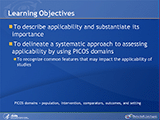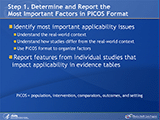- Home
- Slides
- Home
- Tools and Resources
- Research Summaries for Consumers, Clinicians, and Policymakers
- Search for Research Summaries, Reviews, and Reports
- Research Available for Comment
- Submit a Suggestion for Research
- Submit Scientific Information Packets
- Comparative Effectiveness Research Grant and ARRA Awards
- News and Announcements
- What Is Comparative Effectiveness Research
- Who Is Involved in the Effective Health Care Program
- What Is the Effective Health Care Program
Slides
Slides: 1–12 of 89
Rating the Strength of Evidence From the CER
Assays Commonly Used in CDI Diagnostics
Components
Presentation: Analytic Frameworks
Keywords: population | intervention | key question | health outcomes | comparator
Rating the Strength of Evidence From the CER
Number of Studies Evaluating Various Treatment Options
Learning Objectives
Presentation: Assessing Applicability
Keywords: applicability | systematic approach | PICOTS
Three Steps To Assess Applicability
Presentation: Assessing Applicability
Keywords: applicability | PICOS | methods | evidence table | effectiveness trials | body of evidence | population | intervention | outcomes | PICOTS
Step 1. Determine and Report the Most Important Factors in PICOS Format
Presentation: Assessing Applicability
Keywords: PICOS | population | intervention | comparator | outcome | setting | applicability | PICOTS
Comparator and Applicability: Examples
Presentation: Assessing Applicability
Keywords: comparator | applicability
Comparator, Outcomes, and Applicability
Presentation: Assessing Applicability
Keywords: comparator | applicability | outcomes
Evidence Table Template for Applicability
Presentation: Assessing Applicability
Keywords: PICOS | applicability | population | intervention | comparator | effectiveness trial | efficacy trial | PICOTS
Step 3. Consider and Summarize the Applicability of a Body of Evidence From Individual Studies
Presentation: Assessing Applicability
Keywords: applicability | PICOS | body of evidence | PICOTS
Your slide tray is being processed.


 E-mail Updates
E-mail Updates










